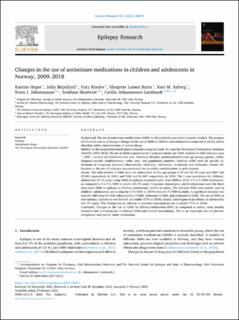| dc.contributor.author | Heger, Katrine | |
| dc.contributor.author | Skipsfjord, Julia | |
| dc.contributor.author | Kiselev, Yury | |
| dc.contributor.author | Burns, Margrete Larsen | |
| dc.contributor.author | Aaberg, Kari Modalsli | |
| dc.contributor.author | Johannessen, Svein Ivar | |
| dc.contributor.author | Skurtveit, Svetlana Ondrasova | |
| dc.contributor.author | Landmark, Cecilie Johannessen | |
| dc.date.accessioned | 2022-05-25T07:23:45Z | |
| dc.date.available | 2022-05-25T07:23:45Z | |
| dc.date.created | 2022-02-15T18:21:18Z | |
| dc.date.issued | 2022-02-15 | |
| dc.identifier.issn | 0920-1211 | |
| dc.identifier.uri | https://hdl.handle.net/11250/2996095 | |
| dc.description.abstract | Background: The use of antiseizure medications (ASMs) in the pediatric population is poorly studied. The purpose of this study was to investigate changes in the use of ASMs in children and adolescents compared to adults, and to elucidate safety considerations of certain drugs.
Method: In this population-based pharmacoepidemiological study we used the Norwegian Prescription Database (NorPD), 2009–2018. The use of ASMs is presented as 1-year prevalence per 1000: number of ASM users in a year * 1000 / number of inhabitants that year. Variables included predetermined 5-year age groups, gender, ASMs, diagnosis-specific reimbursement codes, user, and population numbers. Selected ASMs used for specific indications or subgroups included ethosuximide, sulthiame, rufinamide, stiripentol, and clobazam. Gender differences in the use of valproate was examined due to safety considerations in girls/women.
Results: The total number of ASM users (all indications) for the age groups 0–19 and 20–59 years was 5807 and 47,481 respectively in 2009, and 5906 and 61,447 respectively in 2018. The 1-year prevalence for children/ adolescents (0–19 years) using ASMs in epilepsy remained stable from 2008 to 2018, 4.3–4.2/1000 inhabitants, as compared to 8.2–7.6/1000 in adults (20–59 years). Valproate, lamotrigine, and levetiracetam were the three most used ASMs in epilepsy in children/adolescents, similar to adults. The selected ASMs were mainly used in children/ adolescents, accounting for 0.74/1000 in 2018 versus 0.17/1000 in adults. A significant increase was seen for sulthiame (8-fold), ethosuximide (4-fold), clobazam (3-fold), and stiripentol (2-fold). The use of ASMs in non-epilepsy indications was limited and stable (17% in 2018); mainly lamotrigine in psychiatry in adolescents (15–19 years). This finding was in contrast to extensive non-epilepsy use in adults (71% in 2018).
Conclusion: Changes in the use of ASMs in children/adolescents differ as compared to adults, most notably extensive and increasing use of selected ASMs and limited non-epilepsy. This is an important part of pharmacovigilance and patient safety evaluations. | en_US |
| dc.language.iso | eng | en_US |
| dc.publisher | Elsevier | en_US |
| dc.relation.ispartofseries | Epilepsy Research;Volume 181, March 2022, 106872 | |
| dc.rights | Attribution-NonCommercial-NoDerivatives 4.0 Internasjonal | * |
| dc.rights.uri | http://creativecommons.org/licenses/by-nc-nd/4.0/deed.no | * |
| dc.subject | Epilepsy | en_US |
| dc.subject | Antiepileptic drugs | en_US |
| dc.subject | The Norwegian Prescription Database | en_US |
| dc.subject | NorPD | en_US |
| dc.title | Changes in the use of antiseizure medications in children and adolescents in Norway, 2009–2018 | en_US |
| dc.type | Peer reviewed | en_US |
| dc.type | Journal article | en_US |
| dc.description.version | publishedVersion | en_US |
| dc.rights.holder | © 2022 The Author(s) | en_US |
| dc.source.articlenumber | 106872 | en_US |
| cristin.ispublished | true | |
| cristin.fulltext | original | |
| cristin.qualitycode | 1 | |
| dc.identifier.doi | https://doi.org/10.1016/j.eplepsyres.2022.106872 | |
| dc.identifier.cristin | 2002019 | |
| dc.source.journal | Epilepsy Research | en_US |
| dc.source.volume | 181 | en_US |
| dc.source.issue | 181 | en_US |
| dc.source.pagenumber | 1-8 | en_US |

